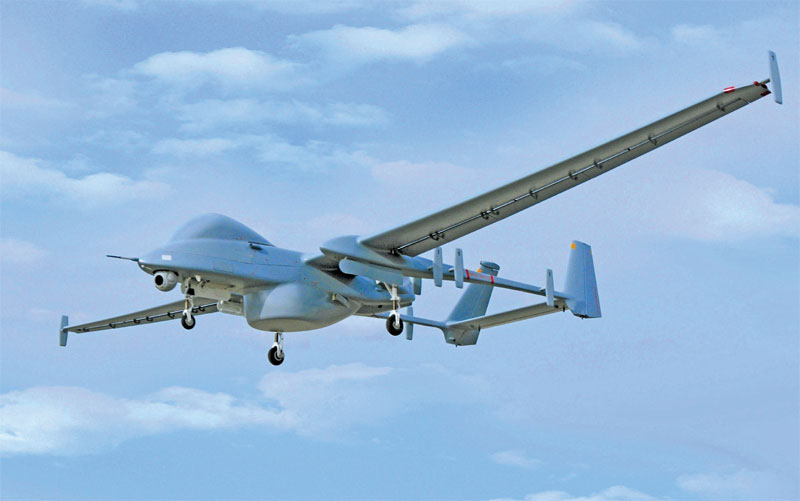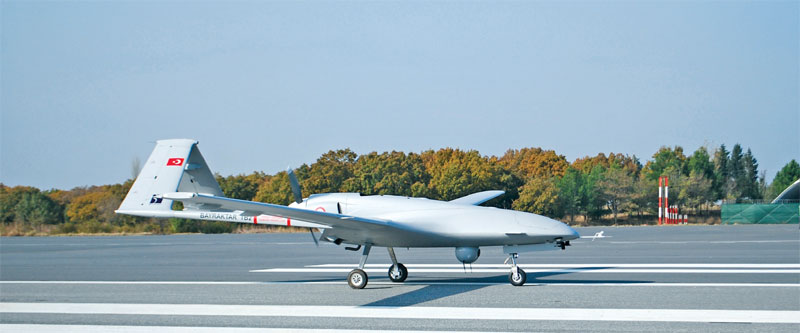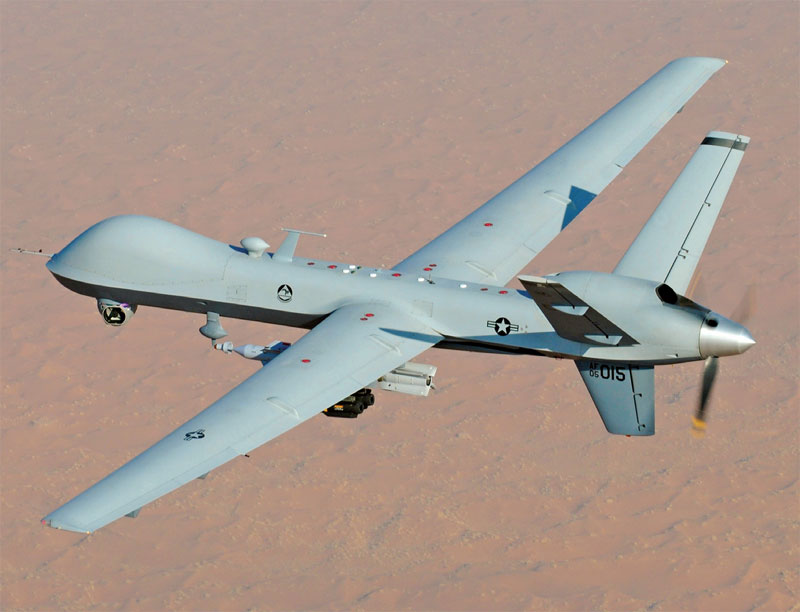Low cost, stealth, zero human fatality give UAVs an edge over manned aircraft
 Gp Capt. A.K. Sachdev (retd)
Gp Capt. A.K. Sachdev (retd)
Research and development in the area of unmanned systems—on land, over and under sea, in air and in space—is progressing at a blazing pace and new systems are being deployed with each passing day. Unmanned Aerial Vehicles (UAV), also termed Unmanned Aerial Systems by some air forces and Remotely Piloted Aircraft (RPA) by some others, including the Indian Air Force, are proliferating by bounds. The term RPA may soon have to be modified as the increasing automation and autonomy being embedded in UAVs is removing the ‘remote pilot’ from the loop for some chunks of their mission, if not all. Ballistic missiles/vehicles, cruise missiles and artillery projectiles, while being unmanned and using the medium of the air, are excluded from the definition of a UAV.
Their increasing availability and low costs (in comparison to manned platforms) has rendered them objects of desire for not just militaries but also non-state and terrorist organisations for a vast number of roles in the battlefield and away from it (in urban warfare etc). The unarmed roles of UAVs include Electronic Warfare (EW), transportation and resupply, communication hubs, weather services, intelligence gathering, surveillance, reconnaissance, combat support, target acquisition and designation, battle damage assessment, special operations and casualty. A sub-set, Unmanned Combat Aerial Vehicles (UCAV), offers emerging roles like aerial combat, suppression of enemy air defences, strikes, manned-unmanned teams, air strikes (in the battlefield and beyond) and kamikaze (loiter and destroy) type missions where the UAV itself carries an integral explosive load and can guide itself to impact with high value targets.
UAV Evolution
Kamikaze UAVs have been making news in recent years but their history goes back to World War-I when the British Ruston Proctor Aerial Target was produced in 1916. It was remotely controlled with the help of revolutionary radio control techniques developed by Archibald Low, who was nicknamed ‘the father of radio guidance systems.’ The project was further modified for use of the platform in suicide strikes against Zeppelins. Another project was the British Hewitt-Sperry Automatic Airplane, varyingly known as the ‘Flying Bomb’ and the ‘Aerial Torpedo.’ It went from Britain to the US in 1917, resulting in an upgraded American version named the Kettering Bug. Although it was considered to be a large success, the war ended before it could be utilised.

In the post-World War-II years, the value of UAVs for surveillance and reconnaissance was realised especially by the US, Russia and Israel. The US used UAVs in the latter part of the Vietnam War in the 1960s while Israel used UAVs (including loitering munitions) in the 1970s and 1980s against their Arab neighbours, Hamas terrorists in Gaza, Lebanon and the Palestinians. In the 1990s, UAVs were employed in the Gulf Wars, Afghanistan, Kosovo, Iraq and the Arab-Israeli wars. The surveillance role was predominant but precision strike roles soon gained prominence with the Predator family being armed with Hellfire missiles. Especially after the 9/11 attack, there was a rush to weaponise UAVs and the term UCAV gained prominence.
In 2019, Abqaiq and Khurais, two major Saudi Arabian oil processing facilities were attacked with 18 drones and seven cruise missiles respectively. The attacks led to around half of Saudi oil production getting affected and a sudden hike in oil prices internationally. In January 2020, US President Donald Trump authorised the military use of an MQ-9 Reaper for the assassination of Iranian military leader Qasem Soleiman, a Major General in Iran’s Islamic Revolutionary Guard Corps. Later that year Turkish drones proved their worth in Syria and Libya, their successes being hailed as the advent of a new military doctrine in the world. The conflict between Armenia and Azerbaijan over the disputed Nagorno-Karabakh region in the same year witnessed an effective use of UAVs.
More recently, UAVs have come of age in the ongoing Ukraine war with both sides using them widely. Indeed, some experts have called it a “drone war” because it is the first large scale war in which military and dual purpose UAVs are being used in huge numbers. In June last year, Popular Mechanics published an article listing seven rotary wing, 24 fixed wing and five loitering munition UAVs in use in the Russia-Ukraine war. The number would have gone up by now as new UAVs are being added by both sides with some spectacular results.

UAVs’ Air Power
Some of the attributes of UAVs have made them easier to use than manned, conventional aircraft and also rendered them powerful instruments of waging aerial warfare without risking expensive combat aircraft and scarce pilots. The absence of a human being on board renders them significantly more suitable for the dull (monotonous, tedious Intelligence, Surveillance and Reconnaissance duties), dirty (involving operating in NBC type hazardous environment) and dangerous (fraught with very high degree of risk to the platform) categories of tasks.
Even if a UAV gets shot down by hostile action, there is no fatality. As there is no human on board, the design can incorporate very high performance features unconstrained by human factors, the most prominent one being ‘g’ forces. Air conditioning, personal oxygen systems, ejection seats and transparent canopies are not needed. Crash survivability design features are less stringent as they are dictated by on board systems and not by a comparatively delicate human being. No cockpit is required and hence the airframe can be made more stealthy and more aerodynamic.
As a trade-off, UAVs can carry additional payload in terms of cameras, sensors or weapons systems. To be able to carry the same payload, a manned aircraft carrying would have to be much bigger, heavier, less manoeuvrable, less agile, less stealthy and more vulnerable. UAVs can theoretically have much more endurance (especially solar powered models), limited only by maintenance needs. The physiological limitations applicable to a human pilot (fatigue, body ablutions, sleep and rest requirements, short and long term consequences of sitting for too long in one posture etc) do not hinder long mission durations. Moreover, their small size and weight, low Radar Cross Section, low acoustic signals and high altitude envelopes are other operational benefits.
The low costs of UAVs in comparison to fixed wing aircraft is another argument in their favour. An operational benefit accruing from their lower cost is that their loss can be risked more imprudently and accepted. These benefits have been depicted in some films and TV series (for example the Netflix serial Fauda) highlighting the immense enabling capability and potential of UAVs not only against terrorists and insurgents but in an assortment of roles and tasks.

UAVs Impact
To use a hackneyed cliché, UAVs have brought about a paradigm change in the way aerial content of wars is executed. In Ukraine, air defence systems—long and short range ones—deterred the use of combat aircraft by Russia once the initial days of the war witnessed high attrition rates. UAVs replaced manned aircraft not only for surveillance, reconnaissance and intelligence gathering but also for strike roles. In December last year, Russian air defences reportedly intercepted Ukrainian UAVs over two military airfields housing long range strategic bombers deep inside Russian territory (around 500 kms from the nearest Russian-Ukrainian border).
In offensive roles, responsiveness is a substantial benefit of UAVs as detection, tracking and engagement can all be tasked to a UAV. In a matter of minutes, an operator sitting hundreds of kilometres away can analyse the information from the UAV’s onboard sensors and authorise weapon use. If the situation changes, the engagement can be cancelled or shifted to another target or another area at short notice. UAVs can stay in an area of interest or loiter over (or close to) a battlefield for protracted periods and be available for employment in diverse roles at short notice, thus truly underscoring the flexibility attribute of air power.
The currently evolving sixth generation combat aircraft have, as an essential design criterion, optionally manned cockpits. That is to say that the aircraft would be able to execute a full mission from take-off to landing without the need for a pilot in the cockpit. In effect, such an aircraft is a UAV, albeit not an inexpensive one.
In addition to optionally manned cockpits, there exists unmanned wingmen in Manned-UnManned Teaming or MUM-T mode (another essential design criteria for sixth generation fighters is the ability to control multiple UAVs termed as loyal wingmen), autonomous UAVs, and swarming UAVs collaborating with each other in real time through edge computing. For highly manoeuvrable swarm UAVs operating in close proximity to each other (as also enemy UAVs) and collaborating tactically, cloud computing is too slow for their cooperative communication. Edge computing eliminates the time taken for devices/UAVs to communicate through cloud computing (which connects through centralised data centres or servers) and processes data on the spot at the ‘edge’ of the network, that is at or near the source of the significant data.
This is the defining feature of swarm UAVs. In a demonstration by Lockheed Martin, four rotary wing UAVs flew coordinated missions while connected to two Verizon 5G network nodes. The UAVs detected and geolocated a target, which was transmitting a low power RF signal, through real time detection data being transmitted over the 5G network and then being processed by signal processing algorithms employing edge computing resources.
The speed at which operations take place is mind boggling and the embedment of Artificial Intelligence (AI) in UAVs is changing the character and conduct of war into ‘hyperwar’—combat waged under the influence of AI where human decision making is almost entirely absent from the Observe-Orient-Decide-Act (OODA) loop. In the future, many UAV missions will be caried out without a human in the loop. Ultimately, autonomous operations could become the norm because even after all the handling and analytics of information is done by AI, the decision-making time at the hands of a human may still be unacceptably long.
UAVs are harshly disruptive to air power theories. As UAVs evolve into long range strike platforms with Beyond Visual Range (BVR) capabilities, they will also contribute to no contact wars in the future. The importance given to strategic bombers appears exaggerated when viewed in the light of UAV capabilities to take over strategic roles. Indeed, UAVs can carry out a targeted assassination role which a manned aircraft would probably be unsuitable for.

Drone Warfare
In February 2020 at an air warfare symposium in Florida, Tesla CEO Elon Musk stated that “The fighter jet era has passed. Drone warfare is where the future will be. It’s not what I want the future to be, it’s just, this is what the future will be.” At that time, his statement invited the ire of most military pilots and set off a raging debate. Today, his words have acquired new meaning. Disposable and economical UAVs are proving to be more efficacious than fixed wing aircraft although the disappearance of fixed wing fighters is still quite distant.
One disadvantage of UAVs is their survivability as they have minimal electronic defensive systems. To improve their flight survivability UAVs are designed at reduced size (miniaturisation and nano technology) and stealth. Crash survivability is another drawback as the absence of a human pilot on board obviates the need for stringent crash survivability parameters.
It is common to compare the cost of a unit UAV with a manned aircraft and reach (wrong) conclusions about comparative cost. While the cost of individual UAVs is far lower than manned aircraft for similar tasks and roles, when associated overhead costs (pilot or operator training, sensor operators, maintenance, fuel, spare parts and communications are all added up, the cost of operating UAVs does not appear to be that much lower than manned aircraft. Given the wide spectrum of sizes that UAVs occupy, a straight comparison is difficult, but one can find the odd academic paper suggesting that the cost of UAV operations is higher than manned options for similar tasks.
Nonetheless, UAVs are a military object of desire as they permit kinetic action to be carried across borders into enemy territory without inviting the same degree of opprobrium as a formation of fighters. Jus ad bellum (which refers to the use of armed force in general amongst states) and Jus in Bello (which regulates the conduct of states engaged in armed conflict) both offer arguments to render the use of UAVs/ UCAVs illegal (or at least controversial) in most of the current employment scenarios where there is no declared war (Ukraine being an exception as a state of war exists there). Targeted killings highlight this aspect as do attacks on oil fields etc.
Advances in UAV/ UCAV technologies and the cost benefits offered by them are drawing attention of leading militaries. India’s experience with them has been half hearted, with indigenous R&D failing to produce noteworthy UAVs and Israeli cooperation making contributions to Indian military inventories (but the cost factor keeping these figures far below those needed). On the other hand, Iran and Turkey have emerged as significant UAV producers and are examples India ought to emulate if it is not to be left far behind. The future, as many an erudite piece of current military literature suggests, is unmanned.

